Small but mighty
Small but mighty
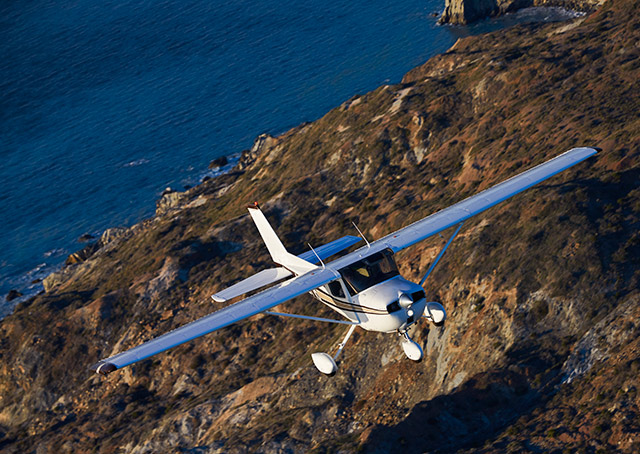
Cessna built 23,902 150s. The 152 came into production in 1978, and the company manufactured 7,593 152s before ending production in 1985.
The 150/152 doesn’t elicit the same type of undying love as the Piper Cub. It will never be as instantly recognizable as the yellow fabric-covered taildragger. Its snug cabin and modest engine are, for many pilots, reason enough to leave it behind once your wallet says you can get checked out in something bigger and faster.
None of this takes away from the trainer’s strengths, which are legion. Let’s look at some of them in greater detail.
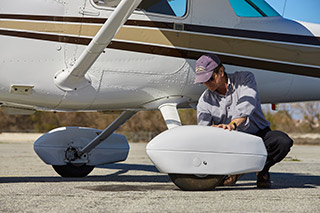 They’re cheap to buy. AOPA Senior Editor Al Marsh called the Cessna 150/152 “the last affordable airplane.” You can purchase one ready to fly for around $20,000. If you have time and money to put into a fixer-upper, it becomes even more affordable. Just ask AOPA Ambassador and Flight Training contributor Jamie Beckett, who bought a 1963 straight-tail C150 for $11,000.
They’re cheap to buy. AOPA Senior Editor Al Marsh called the Cessna 150/152 “the last affordable airplane.” You can purchase one ready to fly for around $20,000. If you have time and money to put into a fixer-upper, it becomes even more affordable. Just ask AOPA Ambassador and Flight Training contributor Jamie Beckett, who bought a 1963 straight-tail C150 for $11,000.
“After pumping a few thousand more into it at the maintenance shop, I had a great flying machine for less than $20,000 total,” he said of the airplane, now leased to the Lakeland Aero Club in Lakeland, Florida.
The low buy-in and low operating costs make the Cessna 150/152 an attractive option for student pilots—especially if two people in the same family want to fly. (See “Twofer,” p. 31.)
Jeff Jacobs of Vancouver, Washington, and his father learned to fly at the same time in the 1960s. Jacobs’ father bought a Cessna 150E for their advanced training. “I passed my commercial, instrument, and CFI checkrides in [it], though its avionics suite consisted of only a single, vacuum-tube-powered, 90-channel Narco Mark 12; a VOR/localizer indicator; a marker beacon receiver; and a panel-mounted stopwatch,” he said.
They’re cheap to fly. Cessna 150s typically fly on 100-horsepower Continental O-200-A engines and can burn as little as 5.6 gallons per hour at 75-percent power. The 152s are a little beefier, with 110-horsepower Lycoming O-235 engines that typically burn about six gallons per hour of 100LL.
They’re durable and dependable.
“It was made to train student pilots, and its landing gear can take a lot of beatings,” said Beckett. The 150 and the 152 are easy to maintain, and parts are readily available. “If you need a new anything, for any reason, there’s plenty of them out there,” he said. Keep in mind the airplane’s trainer history if you go shopping for one, and make sure your prepurchase inspection pays attention to the landing gear.
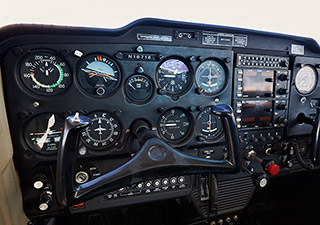 They fly well—but not too well. The airplanes handle well, but they’re not Ercoupes—they teach a new pilot to be vigilant in crosswinds (see “Right Seat: The Best Trainer,” p. 4). Stalls give the student plenty of warning in advance.
They fly well—but not too well. The airplanes handle well, but they’re not Ercoupes—they teach a new pilot to be vigilant in crosswinds (see “Right Seat: The Best Trainer,” p. 4). Stalls give the student plenty of warning in advance.
You’ll never get anywhere fast in a Cessna 150 or 152. Beckett said his 150 gets about 90 knots in cruise. That’s not necessarily a bad thing, and many pilots have wonderful memories of meandering trips in a two-seat Cessna. “My first year with a [pilot certificate], my best friend and I loaded up the 150 with camping gear and set out for a 10-day trip. No set itinerary, just enjoyed the freedom of flight,” said Mike Loeven of Lancaster, Pennsylvania. “Met some amazing people along the way, had some great camping, and saw some places I would not otherwise have ever seen.”
Nearly every pilot who’s flown a 150 or a 152 in strong headwinds can claim that they saw cars and trucks outpacing them. Cary R. Alburn III of Fort Collins, Colorado, has a similar story, with a twist. Flying his long solo cross-country (Anchorage, Alaska, to Kenai to Homer and back to Anchorage) in a Cessna 150, he diverted slightly to dodge some rain. Comparing the chart to the terrain to get back on course, he glanced left to see a flock of Canada geese “pumping really hard to form up on the little blue-and-white Cessna. So I slowed down—even a 150 goes faster than the speed a goose can maintain—and although they had to work pretty hard at it, they flew along beside and behind me for several minutes.”
They teach proper weight and balance. There’s no room for complacency when you’re working with a useful load of 515 pounds (for a 1959 C150) or 589 pounds (for a 1978 C152). Flying the 150/152 might be the best reason for sticking to a healthy diet that you’ll ever need. After all, each pound lost equates to that much more fuel you can safely carry.
They teach pilots to keep track of fuel. Twenty-six gallons of fuel (and that’s with full standard tanks) means a Cessna 150/152 pilot has to know the airplane’s range—and stick to it.
They’re great aerobatic trainers. Economical spin training? Look no further than the 150 and 152. Cessna even designed aerobatic variants, the A152 and FA152 Aerobat, certified for plus 6/minus 3 Gs and sporting a checkerboard paint scheme.
They’re fun to fly. Even if you have to wear the Cessna 150, you’re in for a good time. “Because they’re low-tech, the landing checklist can fit on a very small placard on the instrument panel,” Beckett said. “There’s not a lot that can go wrong with the Cessnas, so you don’t spend any time worrying about them. You just fly.”
Agatha Shilling of West Jefferson, North Carolina, trained and soloed in a 152. She has only fond memories of the snug two-seat trainer, especially when compared with its four-seat brother, the 172. “One day I went for a ride in a 152 and was amazed at the contrast even between those airplanes,” she said. “The 152 feels much more like you’re actually flying, like you are part of the wind and air. I guess that is both the good and the bad, but for me it was good. The bigger the plane, the less I feel like I’m flying.”
“Many of the milestones of my life have been marked by Cessna 150s,” said Jeff Jacobs. “The words that come to mind when I think of Cessna 150s are ‘slow,’ ‘underpowered,’ ‘cramped,’ ‘noisy’...but most of all, ‘home.’”
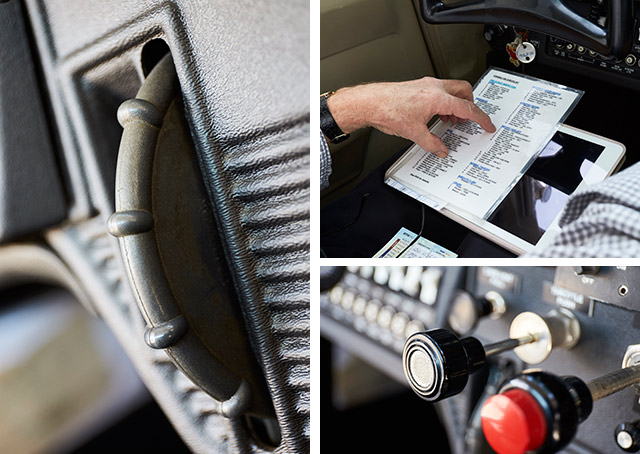
All the instruments a student pilot needs fit easily in the panel of a Cessna 150. You don't need fancy avionics to learn the basics of trim control, checklists, and power management.
Twofer
Father, son solo on a budget
By John Tillison
David Mann Jr. is wearing a pie-eating grin. He recently soloed. His father, David Mann Sr., soloed as well—at the same airport, the same day, and on a budget.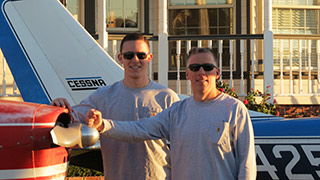
From the start, father and son wanted to fly. Many would love to fly, but current costs make flying a tough sell. Knowing they could barely afford one family member to learn, let alone two, they were resigned to set the dream aside.
A few teaser flights in a Cessna 182 and a Sporty’s ground school course kept the father/son team’s heart in the game, however. Their study, coupled with the flights, culminated into an unexpected benefit: father/son “shop talk.” With each new bit of information, the two volleyed back and forth new concepts and points of interests, creating a type of family fly-bonding.
Still, the high cost of flying was a deal breaker. With even the most economical new trainers going for a cool $120,000, and rentals fetching $90 per hour plus the instructor, both buying new and renting appeared out of reach. So how could two pilot wannabes afford to learn to fly on a “used car budget”? Perhaps buy a used-car-budget airplane.
Mike Tillison (Dave Jr.’s grandfather and mentor) did just that. A 1966 Cessna 150 had been sitting on the north ramp at Sacramento Executive Airport for years. Although the owner kept up with maintenance, he rarely flew the airplane and was torn between keeping or selling it. When an offer came, the timing was right. The little Cessna ultimately sold for the price of a used car.
With original paint, frayed seats, and less-than-perfect plastic, 6915F wouldn’t win any beauty contests. However, three things stood out: primo logs and maintenance, a low-time engine, and its low purchase price.
After a thorough annual; new glass; Whelen LED landing light; new seat cover, belts, and harnesses; and a few other safety enhancements, the Cessna 150 was ready for some serious flight training.
With 97,000 flight instructors in this country, you have to ask yourself, “Do I know a CFI who could lend a hand in training?” Tillison knew one: his brother (yours truly).
To increase the odds for success and long-term follow-through, a plan was devised, with objectives to make the father/son flying experience affordable, safe, targeted for solo, and highly addictive.
There were more cost savings to come: team training. The nonflying student would wait while the other flew. Then instructor and students would hold a team-brief session. After that, the other person would go up. Then another team-brief.
The process worked well to reinforce concepts and keep everyone engaged and on track. If one person was beginning to grease on some landings, the two would talk about it, analyze it, and fuel each other’s fire.
In-flight sessions consisted of maneuvers between Cameron Airpark in Cameron Park, California, and Mather Airport in Sacramento, often with touch and goes at Mather.
The culminating solo flights began with a ruse: a full-stop landing to change a battery.
Family members gathered on the ramp at Mather, sitting in lounge chairs with water coolers, sandwiches, cold drinks, and cameras on hand. To keep expectations in check, prior to “the event,” family were advised of one strict caveat: No one would solo unless each person independently demonstrated required performance levels of ability.
Neither Dave Senior nor Junior had a clue. To them, the family gathering was simply a wholesome expression of support and innocent observation.
Dave Senior was first to fly. After exhibiting consistently safe landings, I told him to make a full stop landing to change the intercom battery. The paperwork was signed off while Senior swapped out the battery. Then, he was given his mission to solo.
They say one of the most memorable days of a pilot’s life is the ecstasy of that first solo flight. The post-solo mood on the ramp was palpable and emotional. Congratulations from ground crews and the control tower made the experience a student pilot’s dream.
Dave Junior summed it up best after his solo by throwing open the Cessna 150 door with a breathless pant, saying, “That was totally awesome!”
John Tillison is a 10,000-hour ATP/CFII and 38-year AOPA member.
Pictured: David Mann Sr. (right) and his son David Jr. (left) soloed on the same day and on a budget by taking advantage of the Cessna 150's affordable price and using team training.



